Budget-Friendly 5 morels Recipes – Save Money, Eat Well
Cooking with 5 morels doesn’t have to be expensive. Try these cheap, tasty, and filling recipes.
Recipes with 5 morels
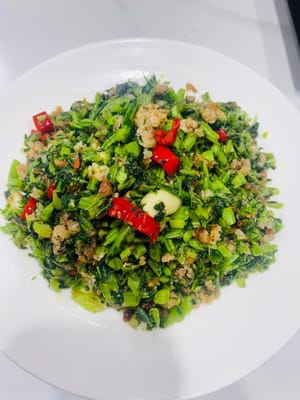
Stir-fried pickled mustard greens with minced pork is a staple at Hunan restaurants—almost every table orders it. The bright green pickled mustard greens are coated in fragrant minced pork, mixed with the slight spiciness of diced red peppers. It's crisp and chewy, with a savory and delicious flavor. It's so good with rice that you can easily eat two large bowls; it's a universally acknowledged "rice-eating king." Going to a Hunan restaurant and not ordering it is like not truly experiencing the authentic flavors of Hunan cuisine!
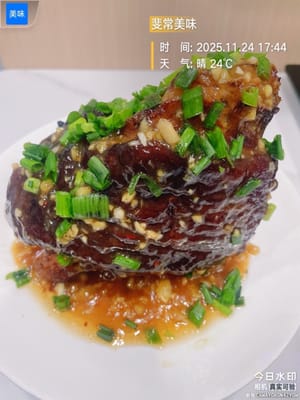
This braised pork knuckle with tiger skin is truly impressive—it's the star dish of any large banquet, and in a restaurant, it's a high-end, impressive dish that holds its own. Placed on the table, its glossy, dark red skin wrinkles into beautiful "tiger skin" patterns, sprinkled with tempting scallions—just looking at it makes your mouth water! The meat falls off your chopsticks with a "plop," the skin tender and the meat succulent, not greasy at all—it's like a "gentle paradise" stuffed into your mouth. If you dip it in the light dipping sauce, it's a "refreshing and cleansing" version; the slightly spicy and sour sauce coats the meat, like a cool breeze on your tongue. If you drizzle it with the thick sauce, it's a "sweet and passionate" version; the rich sauce clings to the meat, every bite is a savory blend of soy sauce and meat, like a "sweet embrace" for your taste buds. If you master this skill, serving it to guests at home will guarantee you'll be surrounded by people praising it until you blush! 😂 Which flavor do you prefer?
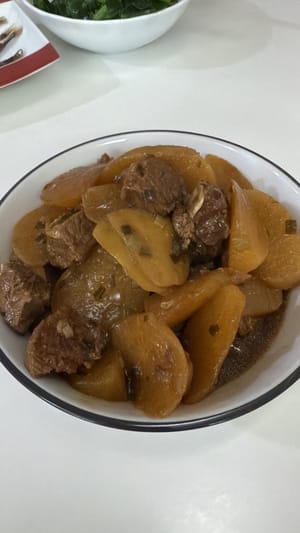
1. Cut the beef brisket into pieces, simmer over high heat, add sliced ginger, add the beef brisket, and simmer over low heat for 10 minutes. Drain and rinse for later use. 2. Peel and cut the radish into pieces. Set aside. 3. Heat oil in a pan, saute sliced ginger, spring onions, garlic, star anise, bay leaves, add minced beef, saute until fragrant. 4. Add white radish, oyster sauce, a little sugar and soy sauce, stir well, add enough water and simmer. 5. Reduce heat, cover and simmer for 20 minutes, until the sauce reduces. Turn off heat and bake for 15 minutes. Then, simmer again over low heat for 20 minutes, turn off heat, and simmer for another 15 minutes.

This Christmas tree stump cake is perfect for those who aren't good at baking! No need to practice frosting; just pipe some chocolate cream, make a few lines with a fork, and you've got that tree stump look. Decorations are a breeze too—strawberries covered in cream make little Christmas hats, sprinkle some sugar pearls, add a sprig of rosemary, and the atmosphere is instantly captivating! No complicated tools are needed; just bake a cake crust, roll it up, and you're done in half an hour. It comes out of the oven with a warm, cozy "winter forest" vibe. Even taking photos for social media is a breeze—just place it on the table, add some pine needles and pine cones, and the ambiance practically overflows from the screen! Bring it out for Christmas; whether for a gathering or as a gift, its beauty and sweetness will be a showstopper, and everyone who sees it will exclaim, "Wow, this is amazing!"

This matcha and red velvet two-tone Swiss roll is simply the epitome of Christmas spirit! The red and green striped roll itself has a Christmas filter, and the strawberries on top are decorated with cream to resemble Santa hats, delicate and cute, instantly capturing the romantic feeling of Christmas and filling the entire Christmas atmosphere. In terms of taste, the bitterness of matcha intertwines with the sweetness of red velvet, paired with sweet cream and bursting fresh strawberries. The dense cake is wrapped in fruity and milky aromas, and every bite is a rich and layered sweetness, making the happiness of the Christmas season even more complete.

"On the left is the non-spicy seafood sauce section: the aroma of freshness hits your nose as soon as it's served. The fish is soaked in the sweet fragrance of seafood sauce, so tender it trembles when you pick it up with chopsticks. My child immediately started gnawing on the fish belly, even chewing the lotus root slices soaked in the sauce with a satisfying crunch, exclaiming, 'Mom, this is even better than what you get at restaurants!'—the seafood sauce gives the vegetables a subtle sweetness, light yet not bland at all. My child even ate rice faster than usual. On the right is our spicy dry pot section: the aroma of the dry pot ingredients fills the kitchen as soon as the sauce is poured on. The fish skin is grilled until slightly crispy, bursting with juice with every bite when coated in spicy oil. Even the celery stalks are infused with the spicy fragrance, becoming more flavorful the longer they cook. In the end, even the last bit of sauce at the bottom of the pot..." It had to be poured over rice and polished clean. The moment this pot of fish was served, the kids on the left exclaimed, "Mmm, this is so tender!" while we on the right were shouting, "Wow, this is so spicy and delicious!" The divider clearly separated the flavors; some were tender, some were fragrant. Even the usually picky kid devoured the lotus root slices. We used a special grill pan for fish that can be heated directly. It bubbled and steamed as soon as the flame was turned on, making it incredibly satisfying to eat and cook at the same time—the kids on the left were plucking at the tender, seafood-flavored fish, while we on the right were enjoying the juicy, spicy pieces of fish, taking a sip of wine, the spicy aroma mingling with the wine's fragrance, enveloped in the warmth—it was so addictive! If you don't have this special pan, a small alcohol stove with a regular grill pan works just as well, filling the air with a smoky, hearty atmosphere. Life is just too good!
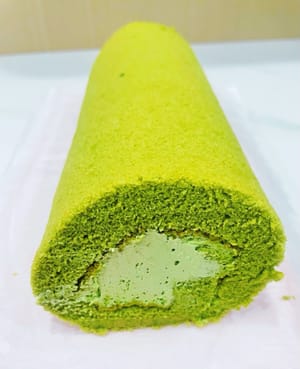
Matcha cream cake rolls have always been a favorite for many, perfect for breakfast, afternoon tea, meeting friends, or taking to gatherings with girlfriends. It has a delicate matcha aroma with a slightly bitter tea flavor, which balances the sweetness of the cream, making it not cloying at all. The cake itself is soft and fluffy like a cloud, melting in your mouth. The cream is delicate and refreshing. Homemade with high-quality ingredients, it's reassuring to use them. Every bite is a refreshing tea flavor, bringing pure bliss. Its appearance is also captivating, with a light matcha green outer shell. Slicing it reveals even cake layers and light green cream, making it incredibly appetizing. Foodies will definitely be asking for the recipe.
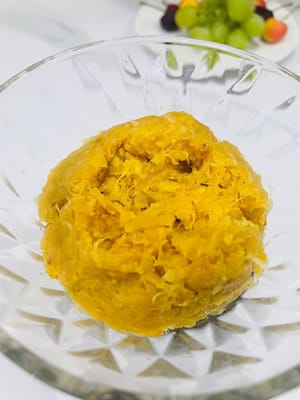
I have always been craving for the pineapple filling with a fibrous texture, but I have been lying down for a long time because of laziness. Recently, pineapples are on the market like crazy, and the price is 3 yuan per catty. If I hesitate to buy them, it would be disrespectful to the "passionate rush" of pineapples! I decisively paid the full amount and picked up 5 in seconds, and the scale weighed about 8 catties. Although pineapples and pineapples are different, pineapples are so expensive that it hurts to eat, while pineapples are readily available and can be easily replaced! When they are refined into golden and sweet fillings, the whole house will be filled with fruity fragrance. I want to make sure that there are real pineapples in the pineapple buns 😝. The key is to make them by myself, and every bite is the joy of real ingredients. The main theme is "eat arrogantly and play crazy"!

Golden and crispy potato cakes, garnished with bright green scallions and finely diced ham, are crispy on the outside and soft on the inside with an aroma that explodes on the tongue.

Nutritious and appetizing dish